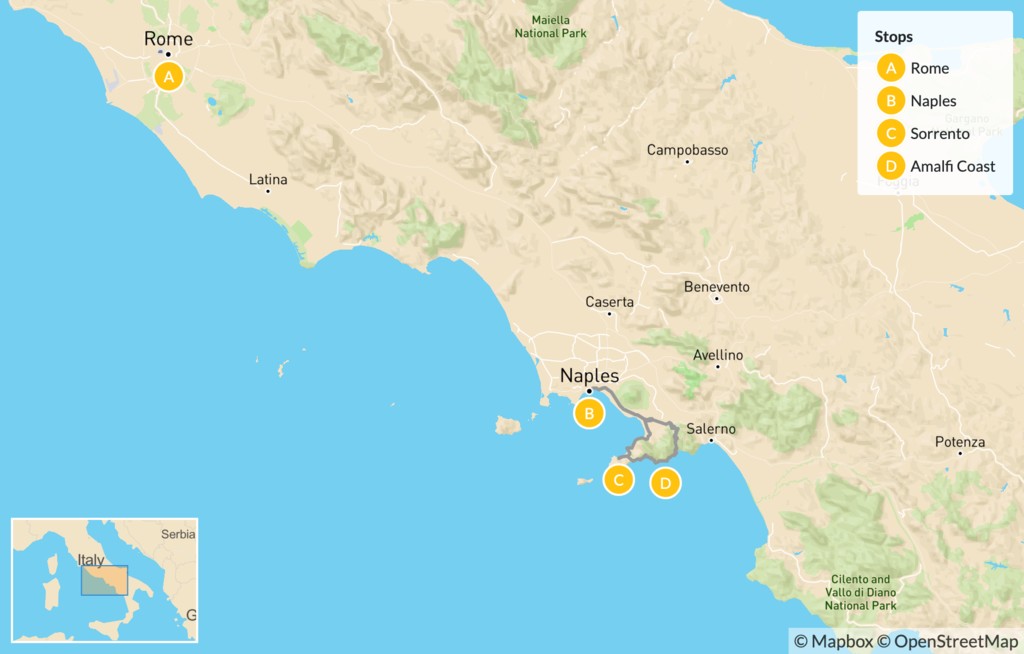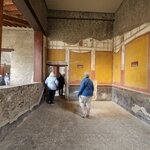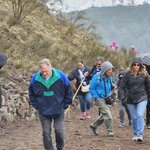Highlights
- Tour the incredible halls and basilicas of the Vatican
- Experience the vibrant culture of Naples and try a famous Neapolitan pizza
- Visit the incredible ruins of Pompeii, preserved by Mt. Vesuvius’ eruption
- Visit the old-time cliffside villages of Positano and Amalfi
- Take a day trip to the island of Capri to see how Ancient Romans spent their summer
Brief Itinerary
| Day | Highlights | Overnight |
|---|---|---|
| Day 1 | Arrive in Rome | Rome |
| Day 2 | Self-Guided Visit of the Colosseum and Forum | Rome |
| Day 3 | Vatican Tour: Museums, Sistine Chapel & St Peter’s Basilica | Rome |
| Day 4 | From Rome to Naples | Naples |
| Day 5 | Naples to Sorrento - Visit Pompeii and Mount Vesuvius | Sorrento |
| Day 6 | Capri and Anacapri Day Tour from Sorrento | Sorrento |
| Day 7 | From Sorrento the Amalfi Coast | Amalfi Coast |
| Day 8 | Free Day on the Amalfi Coast | Amalfi Coast |
| Day 9 | Depart Naples |
Detailed Itinerary
Day 1: Arrive in Rome

Welcome to Rome, known as the City of the Seven Hills! According to legend, Rome was founded by brothers Romulus and Remus in 753 BCE atop Palatine Hill. As the long-time center of the powerful Roman Empire, you'll find nearly 3,000 years of architecture, history, and culture throughout the city.
After arriving at one of Rome's airports, you'll transfer to your hotel in the historic center. Settle in and relax, then head out for a stroll and your first look at the Eternal City. The next few days will involve lots of sightseeing, and you'll spend your first few hours enjoying some of the highlights. Suggested activities include:
- Visit the Catacombs of Priscilla, which were originally used from the 2nd to 5th centuries as burial grounds for the elite families of Rome. The entrance was blocked for centuries to protect against grave robbers, but the catacombs were rediscovered in the 16th century. Visitors can see the original structures, as well as paintings and artifacts from various time periods.
- Stroll through the tangle of narrow streets in Centro Storico, one of Rome's most historic districts, to see classical Roman and baroque architecture.
- Stop to see the Colonna di Marco Aurelio, a Doric column with a spiral of relief sculptures. It was erected in the 2nd century to celebrate the victories of the emperor Marcus Aurelius.
- Head to the Colle Aventino, one of Rome's famous seven hills. Stroll through the Roseto Comunale, the rose garden which sits on the site of a former Jewish cemetery. Then continue to Parco Savello (Orange Tree Park), where you can find the famous keyhole that gives visitors a direct view of the Vatican. Grab a cappuccino and snack from one of the adjacent cafes.
- For an authentic market experience, stop by the Mercato dei Fiori, where locals shop for fresh vegetables, flowers, meats, and cheeses. Browse for authentic Italian pasta and other souvenirs, then take a break with coffee and a pastry at one of the many cafes surrounding the market.
For dinner, head to the Trastevere neighborhood for some of the city's best trattorias.
Day 2: Self-Guided Visit of the Colosseum and Forum

Dive into the history of the Roman Empire with a self-guided visit to the Colosseum, the world's largest amphitheater. Walking through the ancient amphitheater is like taking a trip back to the days of the Roman Empire. Learn about some of ancient Rome's most famous and illustrious citizens, such as Julius Caesar, Emperors Augustus and Nero, and the Flavian Emperors who built the Colosseum.
As you approach the Colosseum, you will see the Outer Wall with 3 levels of arches. Near the Colosseum, stands the Arch of Constantine, constructed to honor Emperor Constantine’s victory in the battle of Milvian Bridge in 312 CE. The Colosseum, the Roman Forum, and the Palatine Hill are all located very close to each other in the same archaeological area.
Recommended Schedule
Best to start early in the morning! Give yourself 2-3 hours to visit the Colosseum- with a little extra time to go through security- and around 1 -2 hours to explore the Roman Forum and Palatine Hill.
While many rush to visit the Colosseum first, the Palatine Hill is typically the least crowded of these three sites and offers an entrance with shorter lines. As it's not the typical order to visit, it is a good idea to start your day bright and early here. As you walk through Palatine Hill, make your way to the directly connected and incredible Roman Forum. Your entrance ticket serves for all three sites, so after making your way through the Roman Forum to see the impressive monuments, the exit will lead you right next to the entrance of the Colosseum.
Tickets & Tips
It's highly recommended to get your tickets online ahead of time and this way skip standing in line. Skip the queue tickets are your best bet to avoid long waits and you can also purchase an audio guide with your ticket, or download an audio tour to listen to while you're inside.
Eating Nearby
After all this exploring, venture to the nearby Monti neighborhood, less than a 10-minute walk, to tuck into a well-deserved meal.
Day 3: Vatican Tour: Museums, Sistine Chapel & St Peter’s Basilica

Today, you will visit the Vatican City museums and Sistine Chapel, as well as other top sights, in a 3-hour guided tour of the city's incredible art and history. The Vatican is not only rich in history, but also in art, housing some of the most important Renaissance masterpieces in the world. You'll visit the Pio Clementio Museum, the Gallery of the Candelabra, the Gallery of Tapestries, and the Gallery of the Geographical Maps.
Continue through the museums to the Raphael Rooms, where you can admire the frescoes before entering the incredible Sistine Chapel and St. Peter's Basilica. Your guide will help you experience the allure of Renaissance art by divulging secret details and untold stories throughout the tour.
The rest of the day is free for you to explore on your own. Stroll through the Centro Storico, the historic center, of Rome, wandering past iconic monuments and architecture such as the Spanish Steps and Trevi Fountain. Head over to Piazza Navona and admire the Fountain of the Four Rivers, designed by the iconic Italian sculptor, Bernini.
Finish your evening with a stroll through the piazza, stopping for some pizza, gelato, and people-watching.
Chat with a local specialist who can help organize your trip.
Day 4: From Rome to Naples

Time to say goodbye to Rome! After breakfast, you'll head to the train station and catch your high-speed train down to Naples, the journey taking just over an hour. Naples sits on a bay near the still-active Mount Vesuvius, which buried nearby Pompeii in 79 CE. There's a lot to see and do here, so make the most of your time in Naples with these suggested activities:
- Visit the Naples Archaeological Museum to see Roman, Greek, and Renaissance-era ruins, including artifacts from nearby Pompeii.
- Tour the Castel dell'Ovo, a seaside castle located on the former island of Megaride.
- See the 16th-century Museo Cappella Sansevero, which houses thousands of veiled sculptures.
- Go underground to see the network of tunnels and passageways built under the city streets.
- Get outside and see the dormant Solfatara volcano, located a half-hour drive west of Naples.
In the evening, we recommend going for a stroll along the Caracciolo e Lungomare di Napoli, a waterfront promenade, then heading to the Quartieri Spagnoli, a lively commercial hub, for dinner at a trattoria. On the way, stop at the Toledo Metro station, the Stazione della Metropolitana dell'Arte, to see beautiful mosaic inlays.
Day 5: Naples to Sorrento - Visit Pompeii and Mount Vesuvius

In the morning, you'll leave Naples and head south to the Sorrentine Peninsula, home to Sorrento and the Amalfi Coast. However, you'll be stopping for a visit of the area's most notable attractions, Pompeii and nearby Mount Vesuvius.
Start by visiting the ruins of Pompeii, a once-flourishing Roman coastal city that was famously buried under ash and volcanic debris by the eruption of Mount Vesuvius in 79 CE. The ash, which killed many of Pompeii's residents, acted as an archaeological time capsule, preserving many of the city's original buildings completely intact. You'll stroll the remains of Pompeii's ancient streets, which are lined with well-preserved villas, shops, public buildings, and plazas.
Afterward, it will be time to visit Mount Vesuvius, which is designated as a UNESCO Biosphere World Reserve. It's a brisk 30-minute hike up a trail to the top. At the summit, you'll be rewarded with stunning views inside the crater as well as panoramic views of the surrounding landscapes and the Tyrrhenian Sea.
After the excursion to Vesuvius, you'll continue on to Sorrento. This city is a long-time favorite with Italian and international vacationers for its beautiful views, tranquil atmosphere, and terraced lemon groves. After checking in to your hotel, take a quick stroll around town.
The city's focal point is the Piazza Tasso, a central square built over a gorge that splits the city. Other notable sights in and around Sorrento include the nearby bay of Marina Piccola, the ruins of Villa Pollio in Capo di Sorrento, the church monastery San Francesco d'Assisi, the 11th-century Duomo, and the Basilica di Sant'Antonino. The latter houses the remains of Saint Anthony, Sorrento's patron saint who died in the 7th century.
Day 6: Capri and Anacapri Day Tour from Sorrento

Spend the day enjoying the sunshine and clear blue waters of Capri Island. Known locally as the "Pearl of the Mediterranean," the ancient Greeks called it the "Isle of Sirens." Capri sits on the south side of the Gulf of Naples and has been a popular vacation destination for millennia. The ancient Romans, in fact, built summer villas here for the Empire's VIPs.
In the morning, you'll head out along the Sorrentine coast to the Port of Sorrento, where you'll catch a hydrofoil to Capri, about a 20 minute ride. Visit the Marina Grande and Marina Piccola harbors, walk along the Belvedere of Tragara (a villa-lined promenade with panoramic views), and explore the ruins of ancient Roman villas.
Then, head up the hill to Anacapri to see the Piazzetta and Augustus' Garden, and enjoy the best views of the Faraglioni Rocks. Should you choose, you can later return to the water and explore the Grotta Azzurra, the famous "Blue Grotto," located inside a hollowed sea cave. Afterward, we recommend spending the remainder of the afternoon soaking in the sunshine on the beach, before catching the hydrofoil back to Sorrento for the evening.
Back in Sorrento, head to a waterfront restaurant for dinner to soak in the view and be sure to try Spaghetti e Vongole, spaghetti with clams, a local favorite that can't be missed.
Day 7: From Sorrento the Amalfi Coast

After a leisurely breakfast, it's time to make your way down and around the Sorrentine Peninsula to the Amalfi Coast. This stretch of coastline south of Naples is renowned for its exceptional beauty and iconic medieval cliffside fishing villages. Lemon groves and sprawling summer villas cling to the steep cliffs that lead to sparkling blue waters.
After arriving at your new accommodation, soak in the views of the coast and sunshine as you stroll through these colorful villages. For dinner, head to the village of Ravello, known for its lemon specialties, where you can pair your delicious meal with a citrus cocktail.
Day 8: Free Day on the Amalfi Coast

Today is a free day to explore the area and enjoy the slower pace of life on the coast. Go for a walk on the Lemon Path in Minori or see the illuminated sea cave Grotta dello Smeraldo. Learn about the local ceramics manufacturing process in Vietri, or go for a half-day hike on the Path of the Gods.
Other suggestions include:
- Visit the beautiful Villa Cimbrone and Terrace of Infinity in Ravello
- Soak in the sunshine on Gravitella Beach in Vettica Maggiore, Lannio Beach in Centra, or Arienzo Beach in Positano
- Try your hand at windsurfing in Praiano
- Check out Praiano's nightlife at the Africana and Music on the Rocks nightclubs
- Rent a kayak and explore emerald green grottos, tiny hidden beaches, and impressive sea caves
- Enjoy a quiet day in the serene town of Atrani, far away from the hustle and bustle of the larger villages
- Explore the Fiordo di Furore, Italy's only fjord
- Visit the Cloister of San Francesco in Sorrento, an oasis of tranquility that's located steps away from the town's historic Sant'Antonino piazza
- Enjoy nature in the Ferriere Valley Nature Reserve, famous for its postcard-perfect fishing villages and striking countryside crisscrossed with hiking trails
For dinner, head to Ristorante Pizzeria Giardiniello in Minori for the best Italian pizza, paired with a glass of delicious local wine.
Day 9: Depart Naples

Time to say goodbye to Italy - for now! Transfer to the airport for your flight home. Safe travels!








